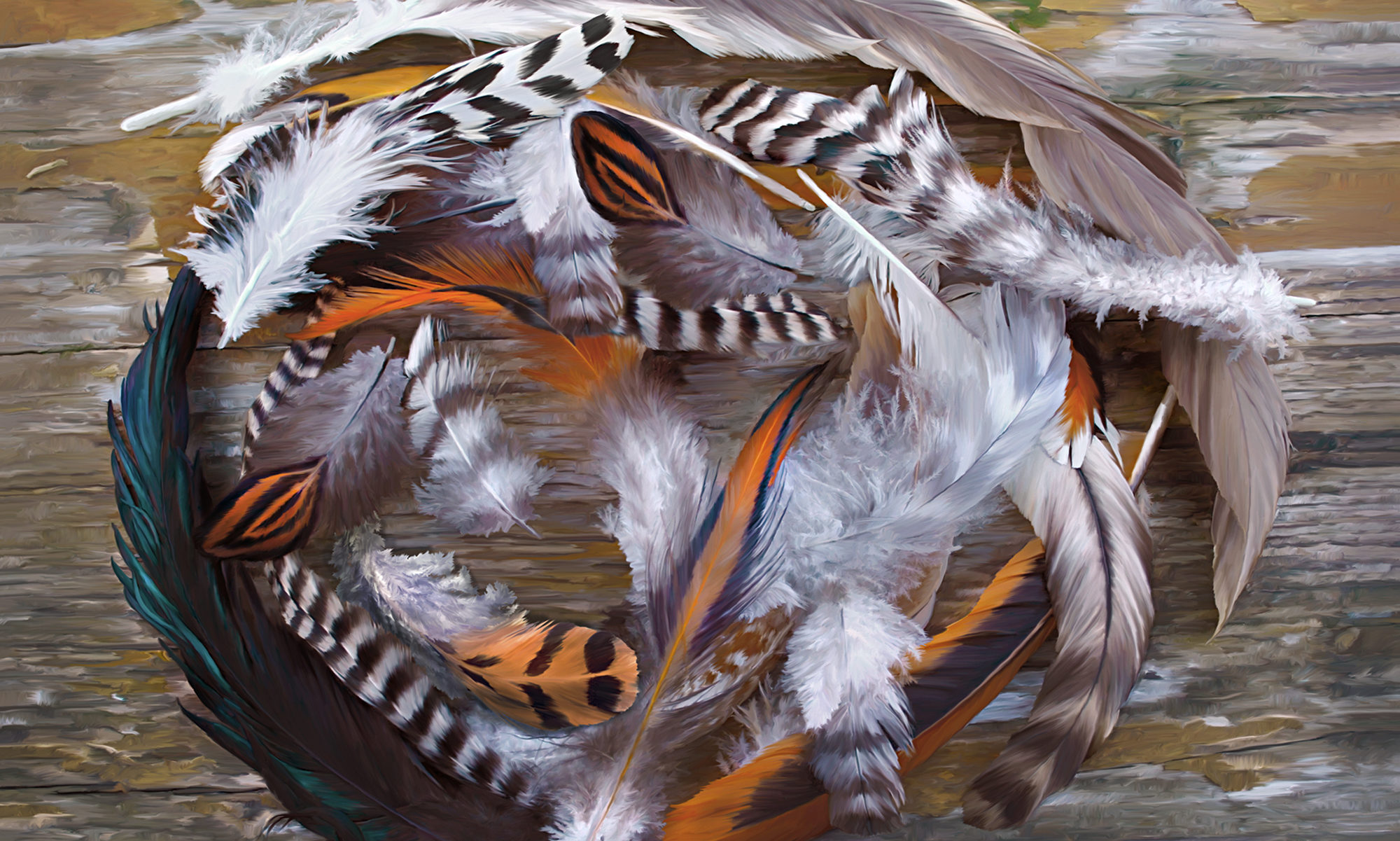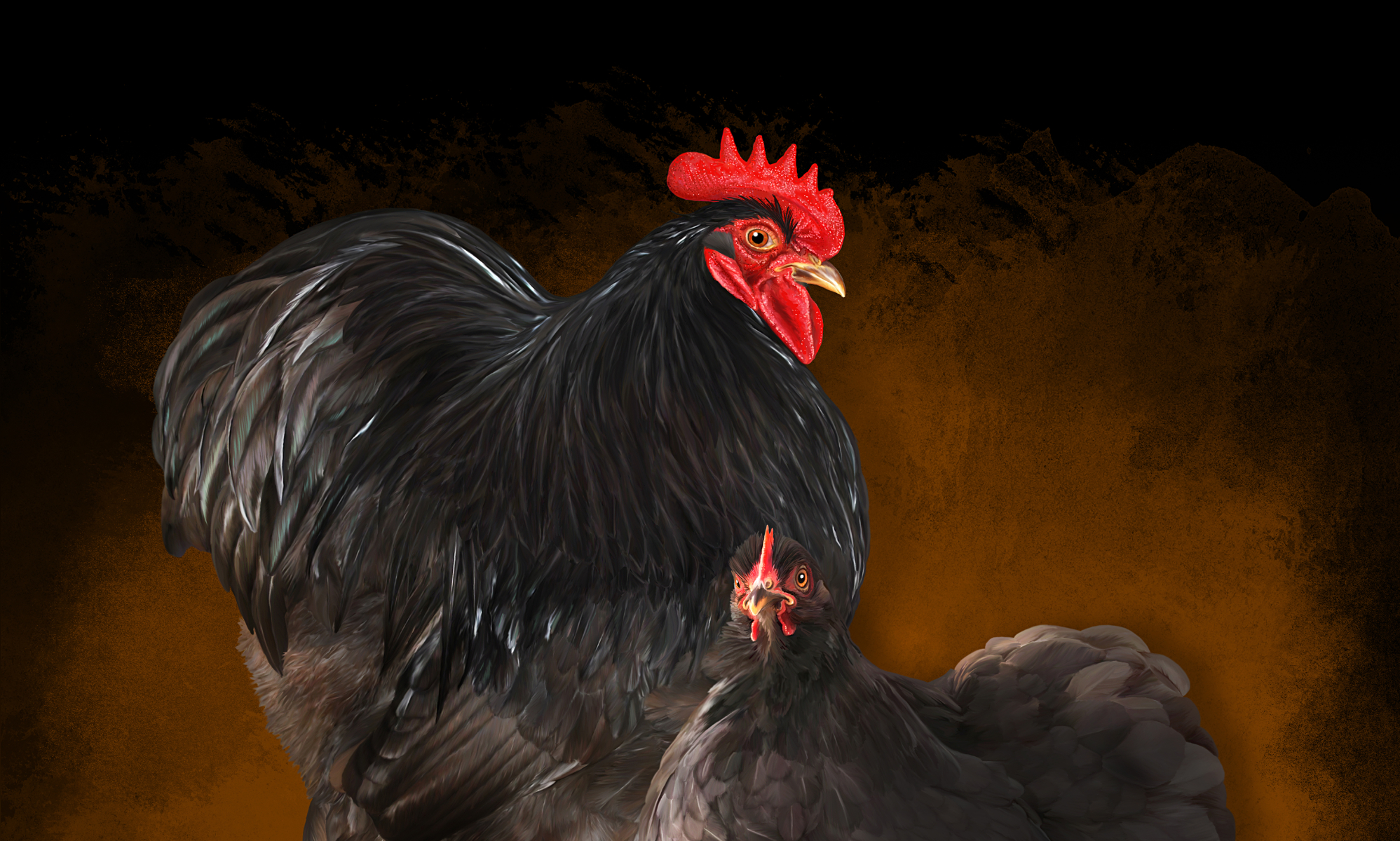Articles on all kinds of chicken matters, enjoy!
My articles are free to read and download to your own genetics references. Especially for those who are familiar with chicken genetics as explained in the books. Some of the articles go beyond the basics, for those hungry for more stuffies.
Bottomscroll for the latest articles.
All materials have © copyright, for use contact me.
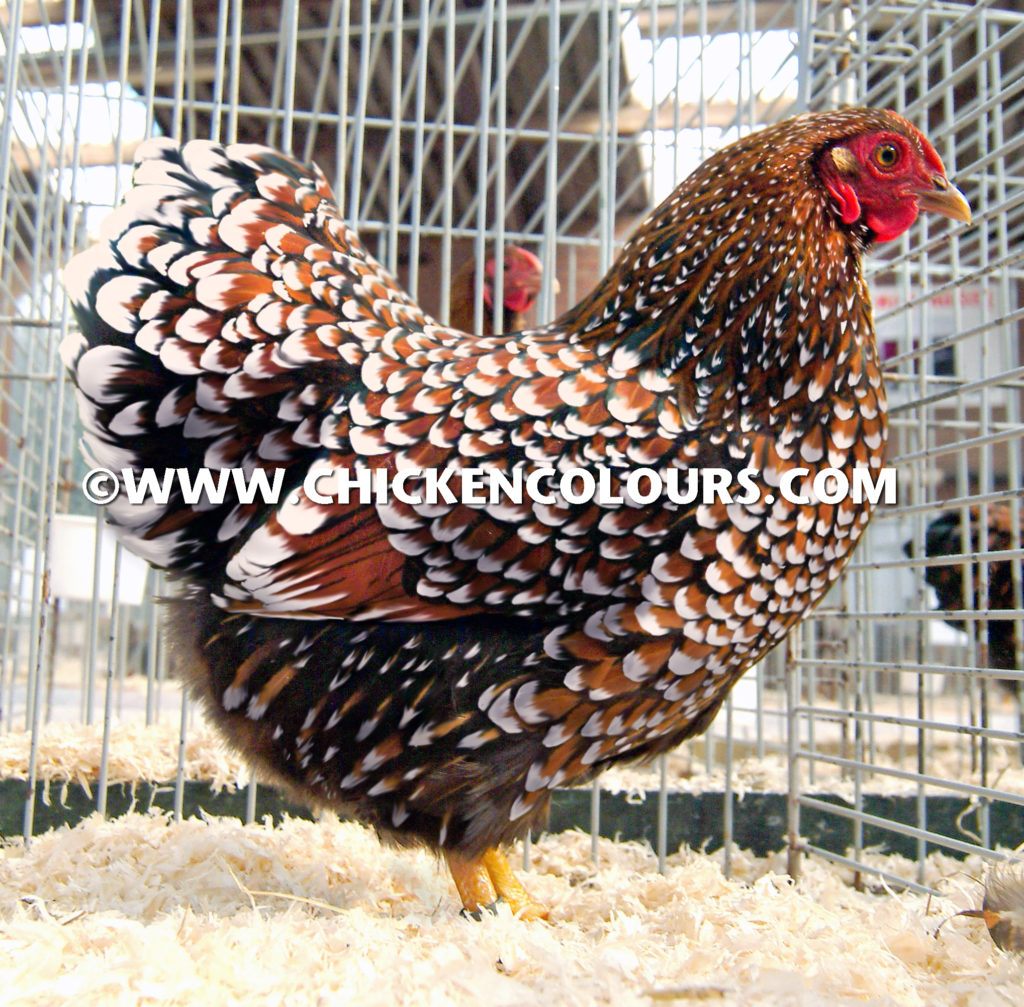
The mock-up illustration of the Tollbunte Wyandotte from 2008.
On request of several, below the recipe for creating Tollbunte Wyandottes.
Meanwhile they are already existing.
Year 1: (red)mille fleur x gold laced, sex doesn’t matter because these patterns are autosomal, the same on both sexes. Amount of animals: see for yourself, they are all carrying mottled but the other genes are impure. Red mille fleur on Wyandottes is ‘random, which means its only the action of mottled which causes the flower (red, black, white). It’s possible they carry columbian, but that’s only usefull. F1 will be impure of e-allele, because you are crossing wheaten (eWh) x Asiatic partridge (eb). Chicks will have different down colours, document this. Light chicks have eWh, striped eb.
Year 2: F1 (offspring of year 1) cross to eachother (inbreeding), at the end of the Summer, select the ones with the best mottles, e.g. a cockerel and a pullet. Because of impurity of e-allele, the chicks will look different (pure wheatens, pure asiac partridges, mixes). The wheaten chicks will be yellow with a vague shade of red on the back, the asiatic partridges will have chipmunk stripes and the mixes vague stripes and some can have a dark head spot (columbian gene).
Attention: impure (Mo+/mo) mottleds can show mottling in their youth feathers, esp. the cockerels. Therefore wait till the end of the Summer, when they’ve moulted fully to adult plumage. After moult the white feathertips may disappear. The amount of animals: quite some, statistically 50% carries mottled 25% is mottled and 25% zero mottled, based on 100 chicks. Nature not always follows statistics.
Year 3: F1 from year 2 with mottling x gold laced. Offspring won’t be mottled, but does carry it. See Attention above.
The other way in year 3: Inbreed F1 from year 2, this can result in a pretty nice single lace. This F2 has variable mottling. Sometimes you can create something looking pretty much Tollbunt. This F2 is mottled in a certain way, it can vary in intensity and distribution. Sometimes with a bit of selection its possible to have a Tollbunte but the base is very narrow. You can breed two lines from the start (reciprocal, swap male and female) and mix them at this point.
Year 4: F1 from year 3, inbreeding, at the end of the Summer select birds with best mottling and lacing. Technically, laced should be pure now as well as mottled. The Tollbunte Wyandotte could be a fact, although a rough one, the picture is a painting over a photo: this is not reality!
PS.
For the ground colour: in red millefleur there is mahogany, this is persistent. When you want a gold ground colour, you’ve to breed a lot and select the least red birds, it will take some time before you get rid of Mh. Another way is breed back to gold laced every time, and not select them earlier than the age of 1,5 years, when their hormones are in full swing. Hormones influence colour: red in males, black in females.
HAVE FUN!
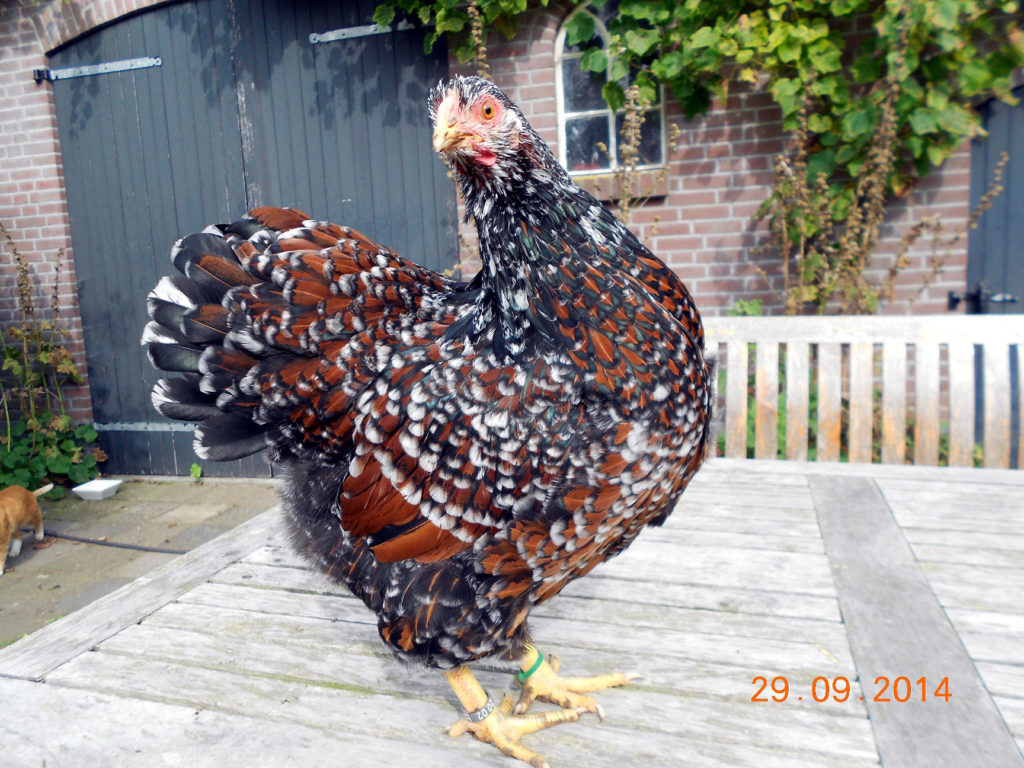
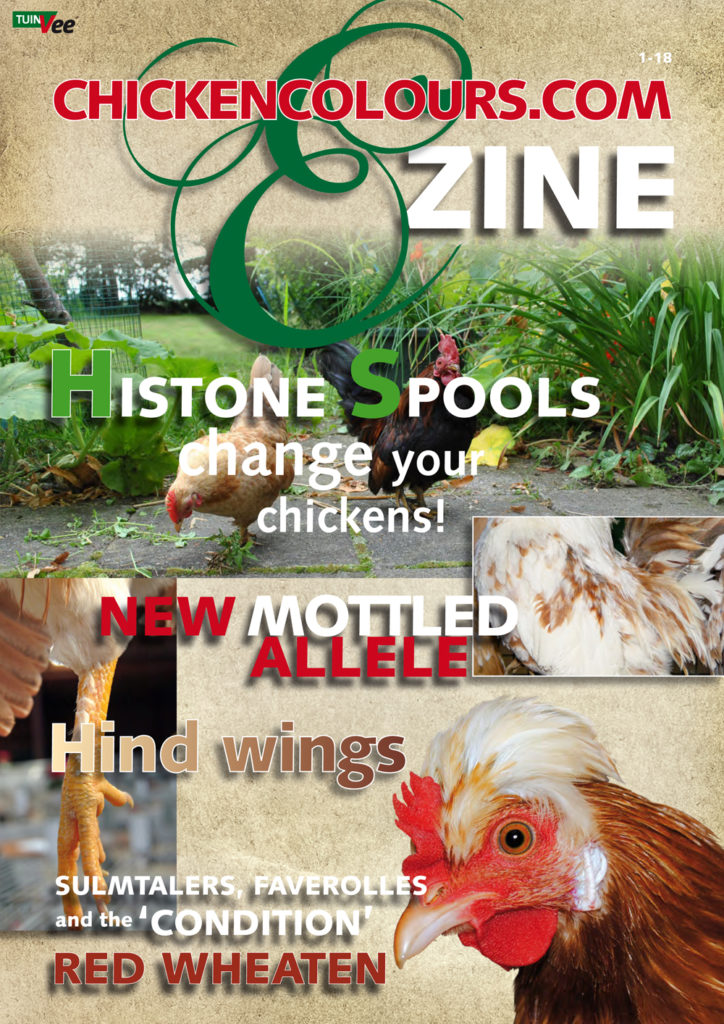
A chickencolours E-zine with 4 articles at once (2018)
– Histone spools
– New mottled allele mo^w
– Leg feathers
– On red wheaten.
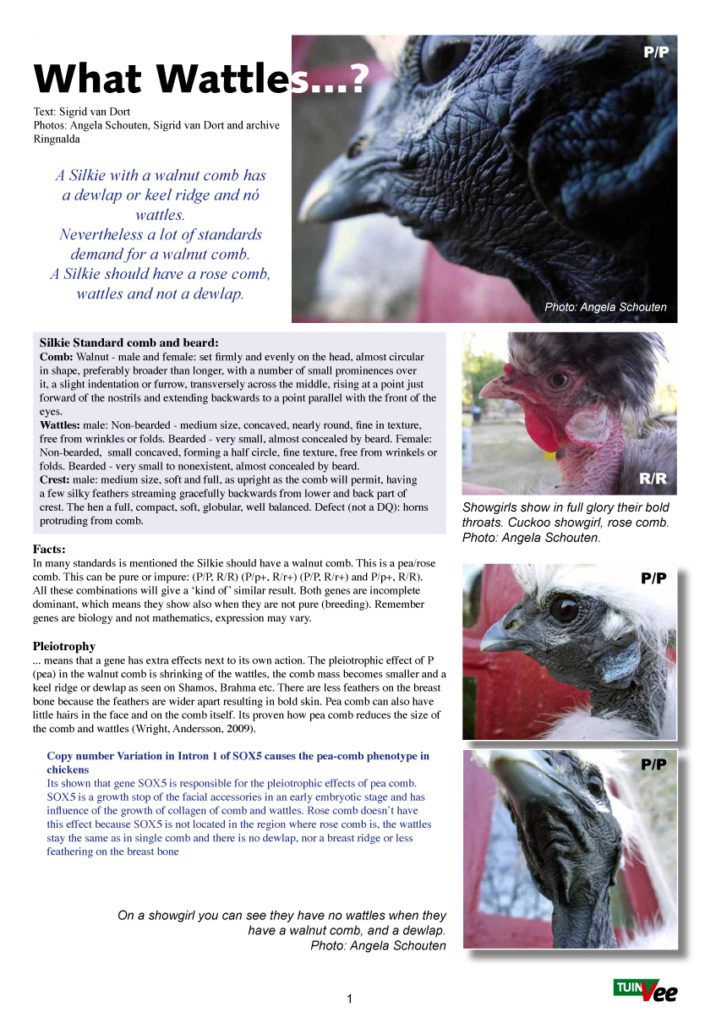
What Wattles is about the wattles of Silkies. They should have a strawberry comb, which doesn’t exist, it is a visual description of shape only. The non-bearded Silkies should have wattles. Why do a lot of non-bearded have no wattles? And do judges pay attention to it?
There is a relationship between comb type and wattles…
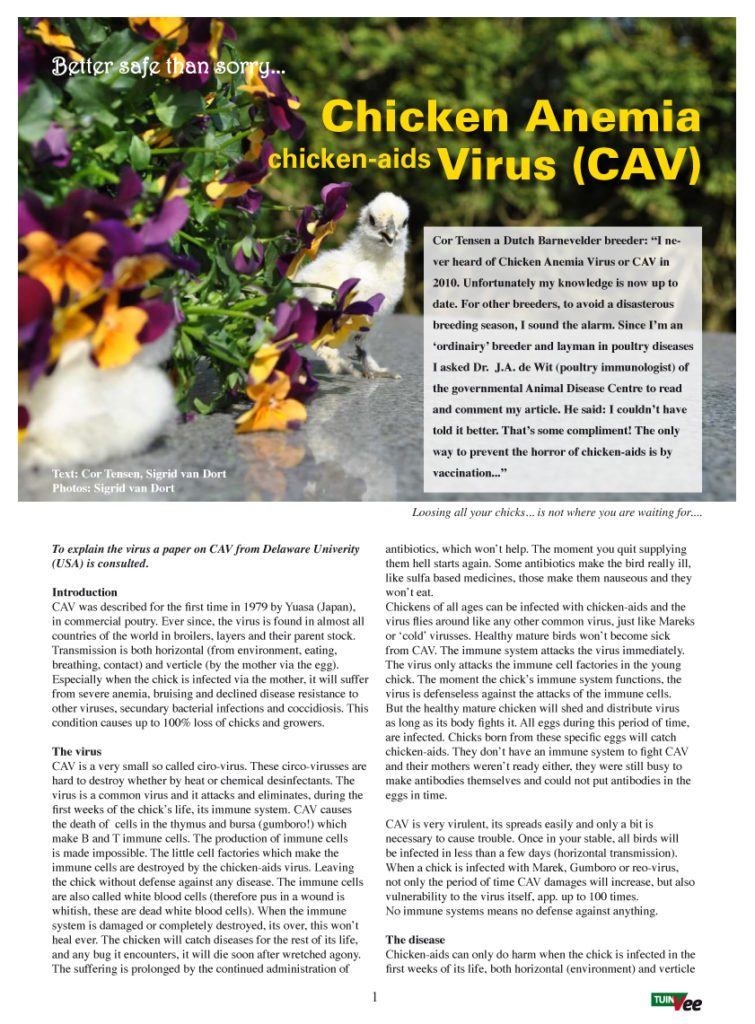
Chicken Anemia Virus (CAV) or Chicken Aids, not easily recognised SHIT
Something both fanciers and veterinarians don’t know. It started in 2010 in Holland in some private flocks. CAV is part of the standard vaccination program of industrial poultry. How it jumped into backyard chook is still unknown.
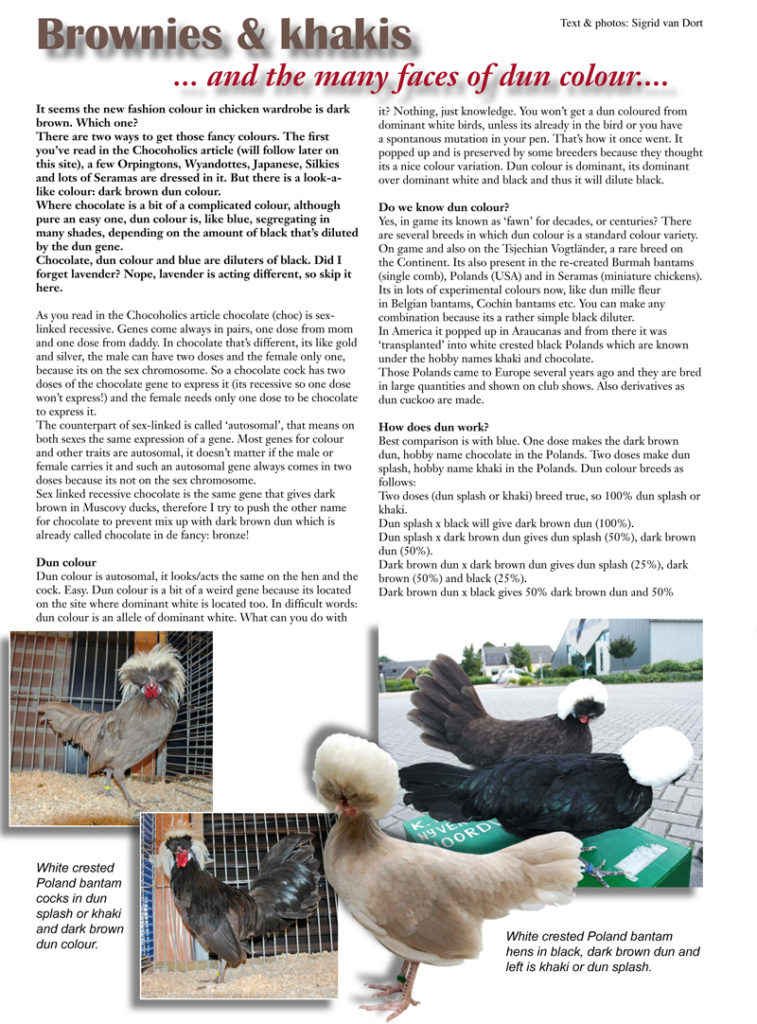
An older article from the time dun and chocolate were not quite understood. This is a separate one on dun colour where it is compared to the action of blue and how it works in a comparative way.
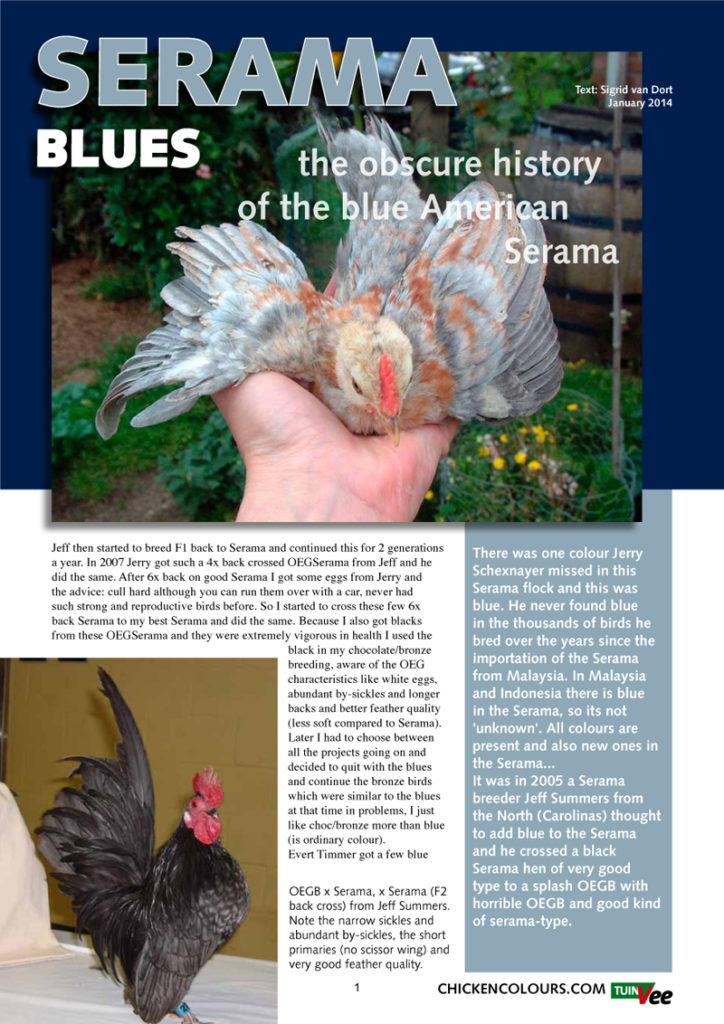
The obscure history of the blue American Serama
Story about borrowing a gene from another breed. Creative breeding, the definition of ‘breed’ is ony determined by selection. You can make a Serama from a Brahma. When it looks and breeds as a Serama, it is a Serama.
That is one of the blessings of domestic chickens, they are all the same, just different looks.
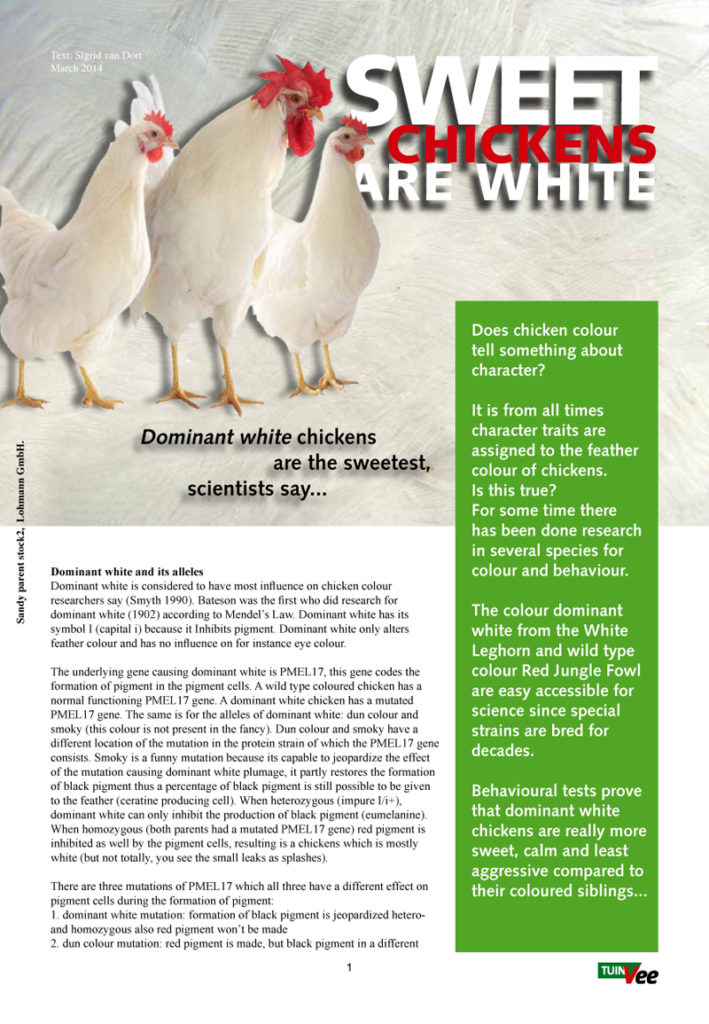
Dominant white chickens are the sweetest
That is the message of the article since the causative gene of dominant white has a by-effect on behaviour which will please you and other chickens.
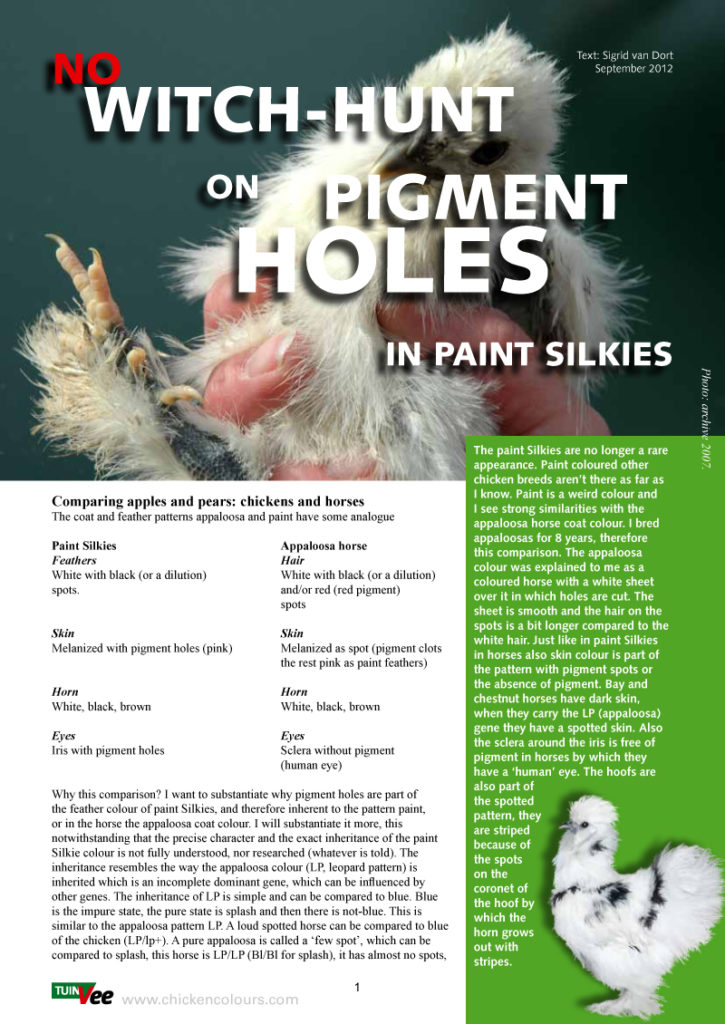
Old article on pigment holes in paint Silkies. Dominant white hits holes in skin melanisation. It is part of the gene, yet if you only breed with birds without holes, it seems to become less. Because it is part of the gene, I ask for tolerance. I thought it would be something similar as B (cuckoo/barred) and skin melanisation, demanding dark skinned cuckoo Silkie is a dead end road too. Anyway, holes continue to be seen, even after 10+ years.
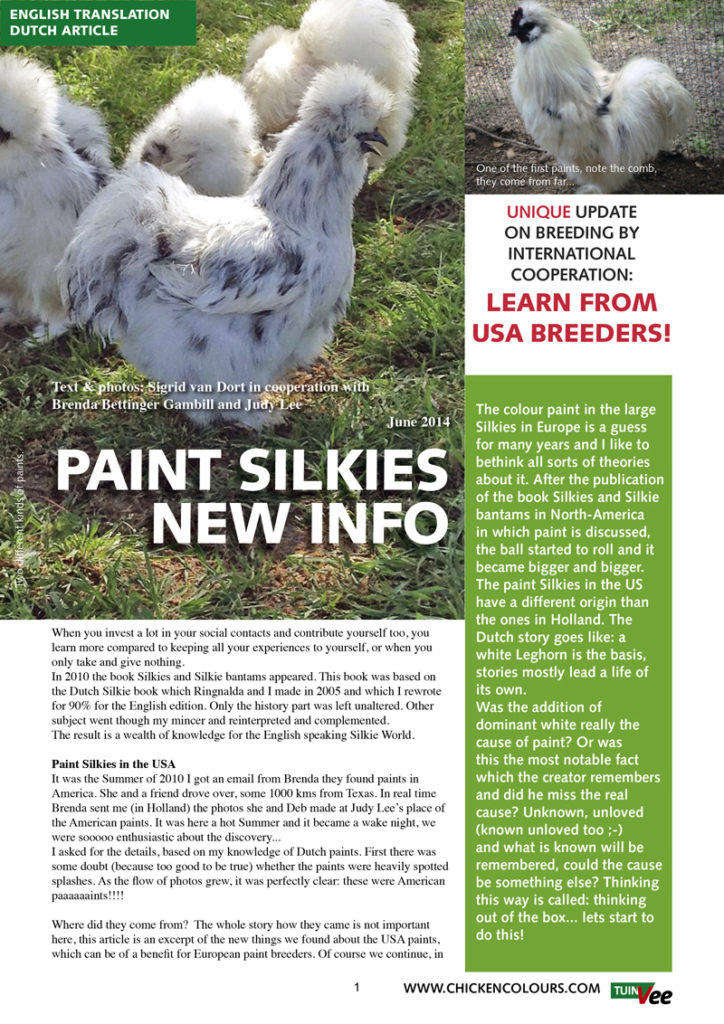
An update on paint Silkie experiences and documenting them. In origin it was a dutch article, one of the last since I don’t write dutch anymore.
The experiences are not ‘science’, they are personal observations.
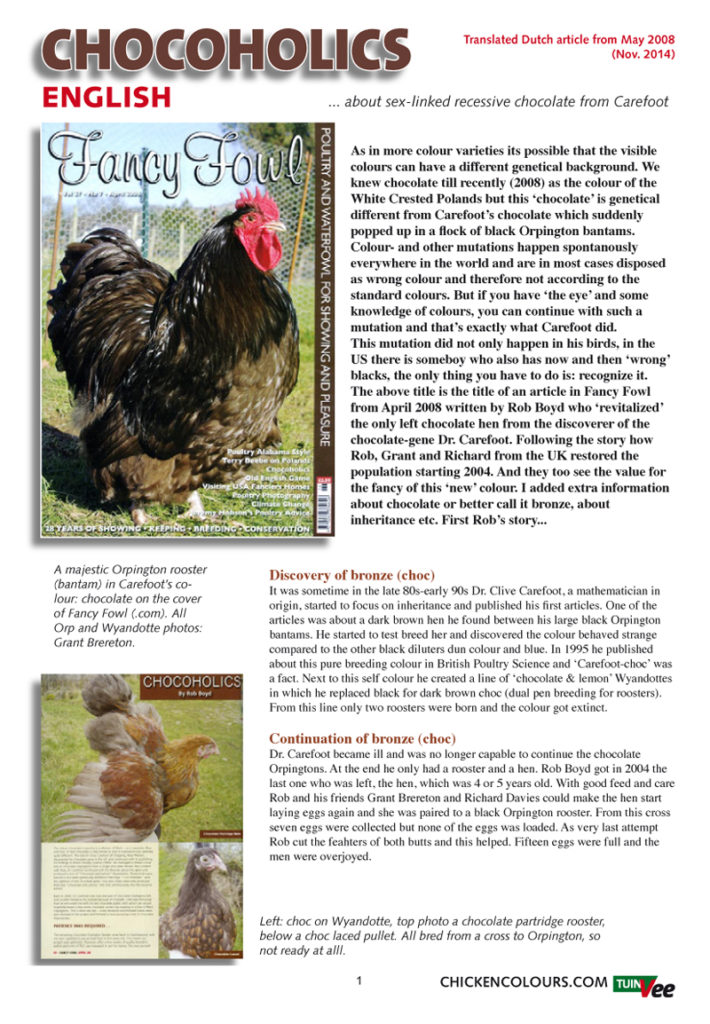
Chocoholics
An article from 2008 updated in 2014. Since it is about plain explanations it is still actual. For the ones who need a simple explanation to read. In 2008 not many chocs were around. I just discovered choc in Serama, the only known other chicken was the Orpington bantam in the UK, carrying recessive sex linked choc. From Serama it went into Silkie and Chabo in my breeding. Many breeders of bantams came to visit for a choc Serama to put in their favourite breed. The rest is known.
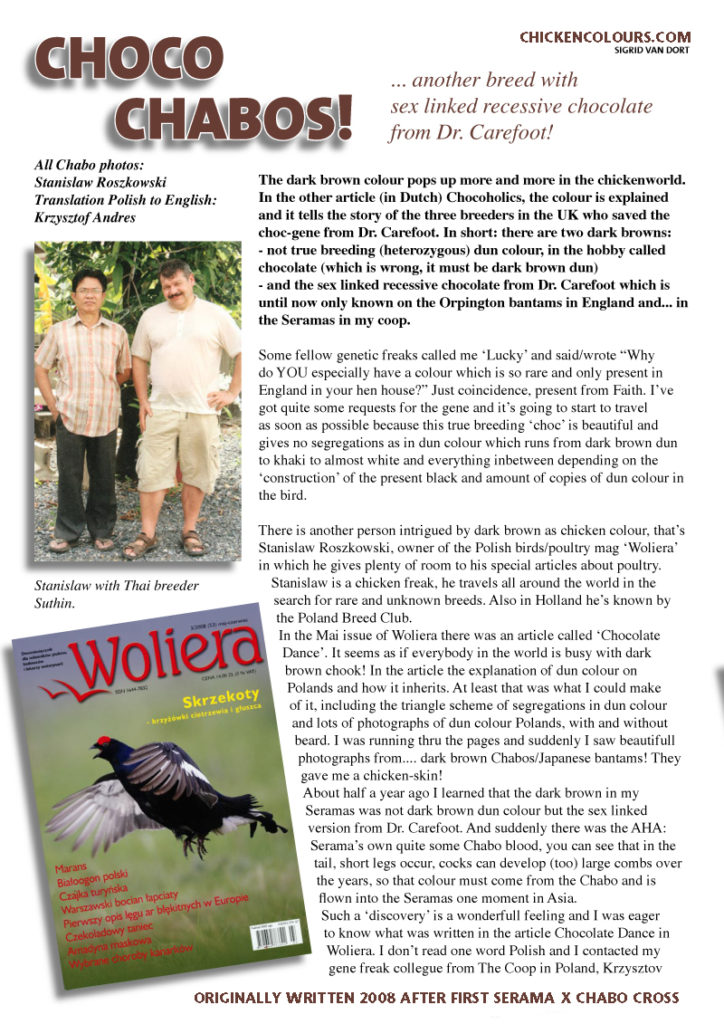
Choco Chabos (Japanese bantams)
Another 2008 article, based on an article in the Polish magazine Woliera from Staniszlav Roszkovzki. It was coincidence, while the first eggs of choc Serama x Chabo were in the incubator this magazine arrived by the mail. It took quite some effort to translate polish, to incorporate what was written in this article. Meanwhile the choc Chabos (Japanese bantams) are accepted in Germany in February 2020..
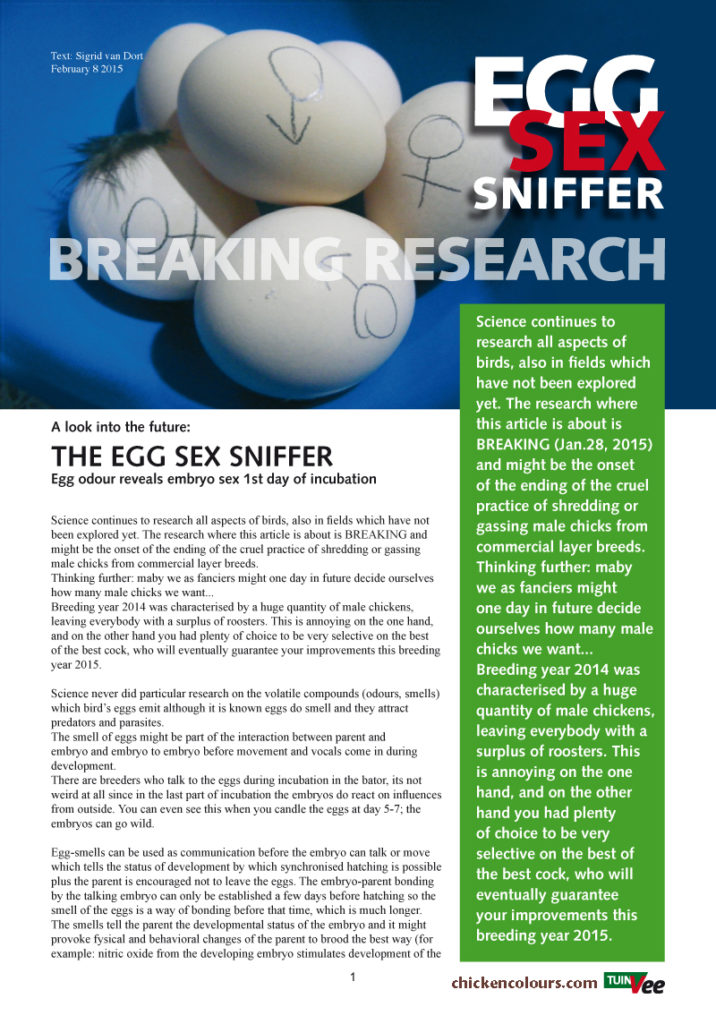
Sniffing the sex of the embryo
In 2015 an article was published in a science magazine on the ‘exhaust’ fumes of hatching eggs by the embryo. This sparked the idea to write this article.
Explained is how the researchers sniffed out the male and female embryos. Today (11-2019) there is still no commercial application of this finding. But that doesn’t matter. Several countries want to ban the shredding of male chicks just after hatch. Maybe one day there will be a solution.
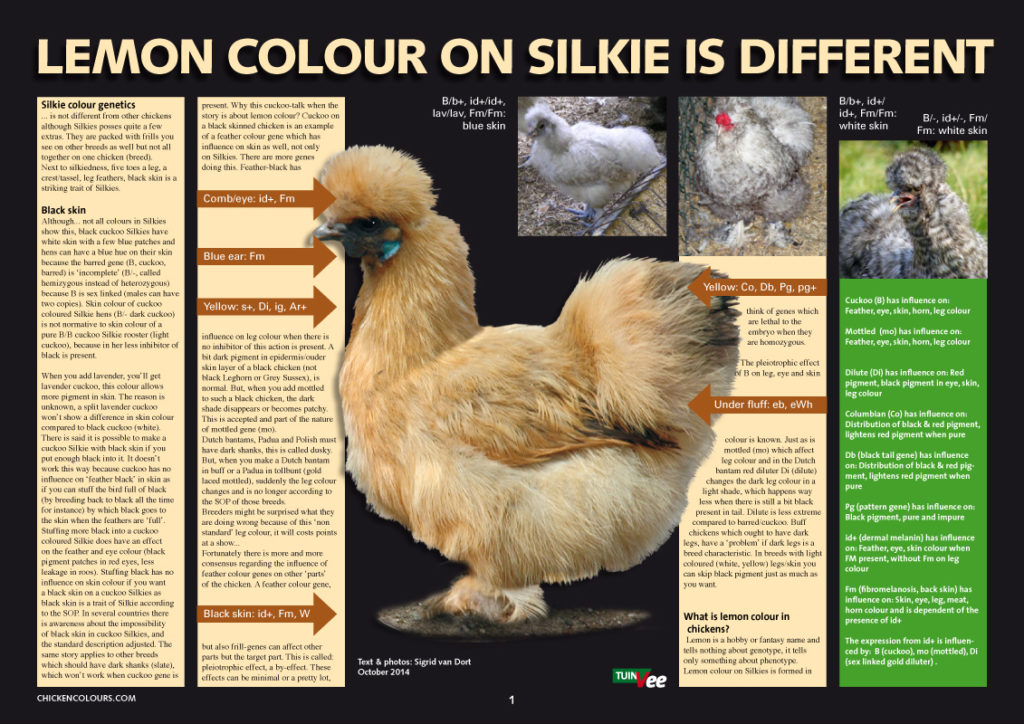
Lemon Silkies or some call the mini-Silkies, because some can be small bantams. How to get this colour and what are the consequences for other Silkie traits when feather colour is very light gold? There are several ways to get a lemon feather colour. What is lemon feather colour? How do you identify it?
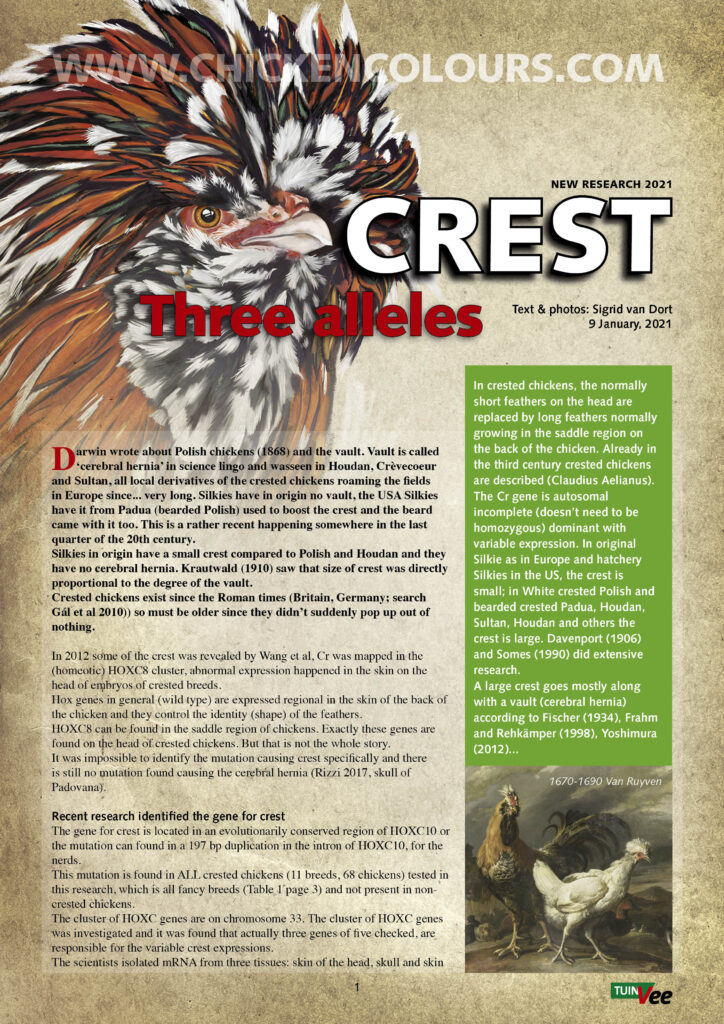
Gene for Cr (crest) located, January 2021. Article on the findings on the crest gene and its three alleles found in specific ornamental breeds. Mentioned Silkie, Houdan, Polish, Padua etc. and white Leghorn as wild-type cr+.
Article is four pages and written as easy as possible.
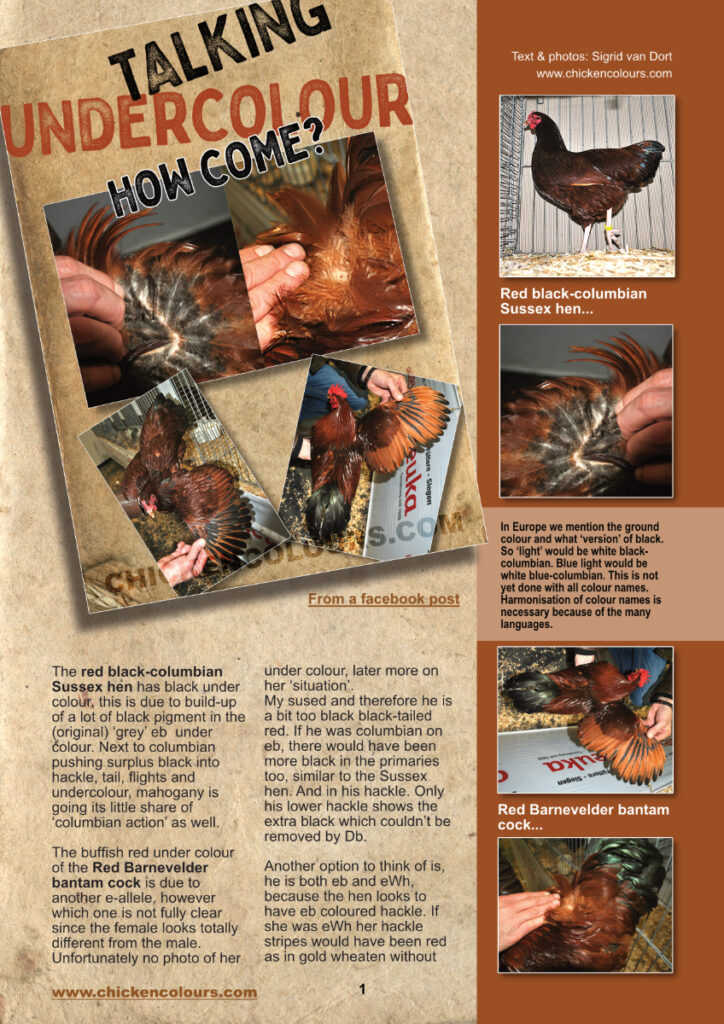
Talking about undercolour (of reds)
Sept 2022. Why does one red chicken have a black under colour and another buff? As an example two chickens were used at a show in Hannover. This article explains why there is this difference in undercolour..
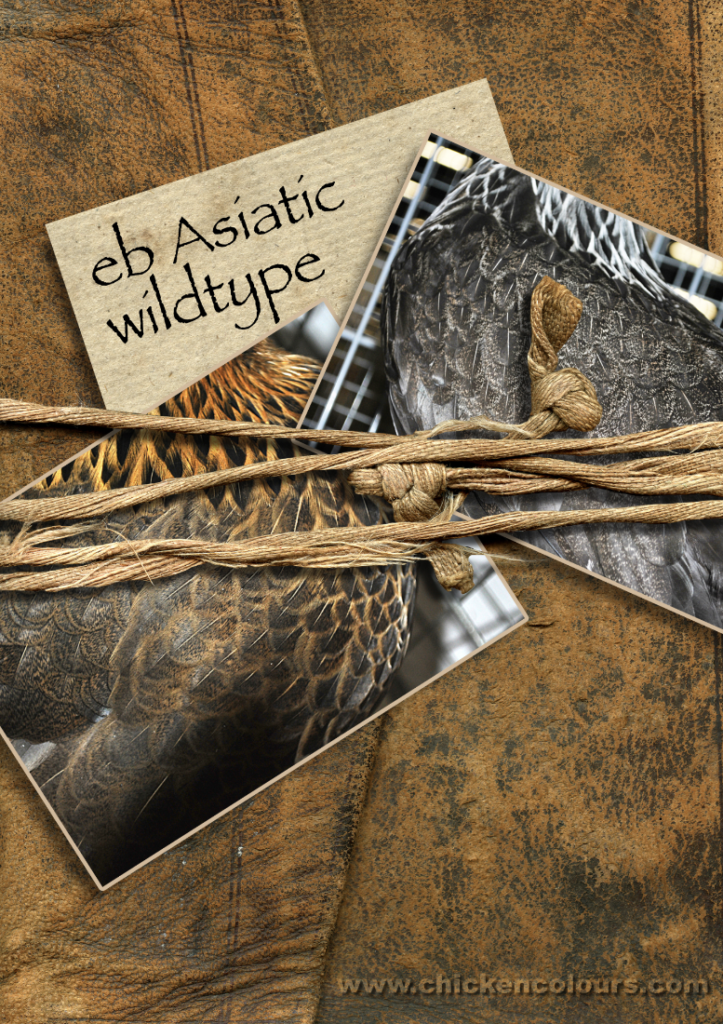
eb Asiatic ‘wildtype’ partridge
Sept 2022. The breast of an eb hen without lacings is eb pg+. Her breast is just as peppered/stippled with black pigment as the rest of her body.
We are not really used to this colour variety, it is rare. We are used to partridge and silver pencilled (dark). Here more on this basic colour.

Multiplex Freak Combs
Sept 2022. An article based on a 1946 paper of Taylor who created multiplex combs. Nightmarish headgear is the result. You can do this too at home ?
He crossed single x rose comb. Some modern examples of my chickens too.
You get this when you create new colours and have to mix breeds.
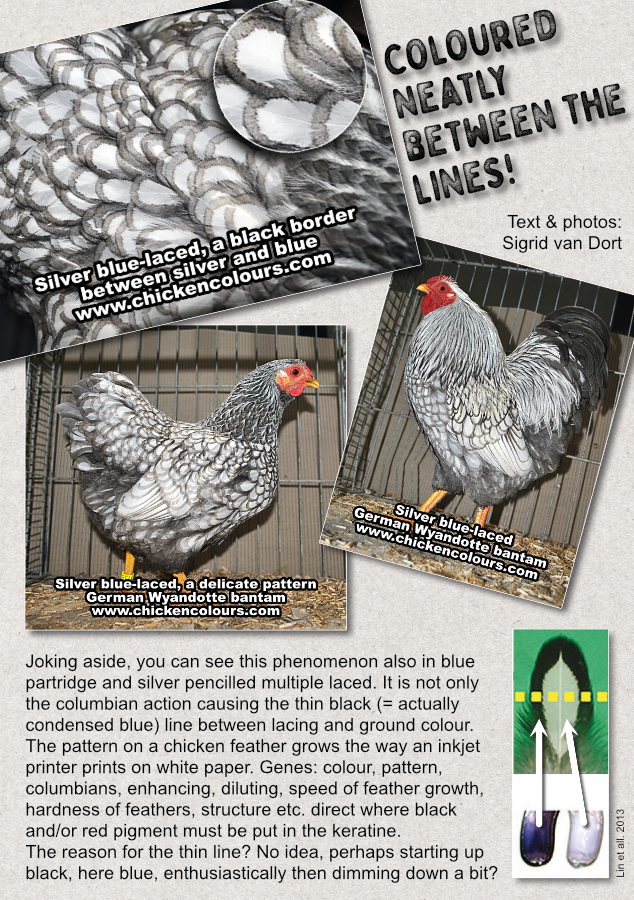
Who coloured neatly between the lines?
Sept 2022. A strange phenomenon seen in blues, a little dark border around the blue part of the feather, either single laced or a partridge variety (multiple laced). The reason is unknown. A guess… One page article.

On red blue (double) laced, who coloured neatly between the lines too?
Sept 2022. This page belongs to the silver blue-laced Wyandotte (above here). She has fine black-blue lines between the silver ground colour and blue lacing. The same happens when the ground colour is gold. Here with mahogany (Mh) on blue double laced.
One page article.
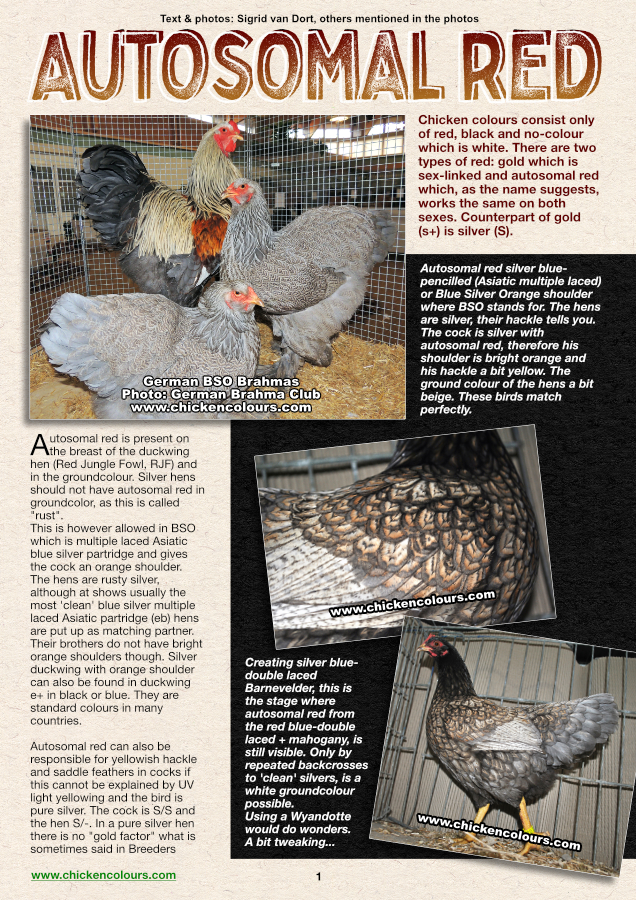
Autosomal red – once again…
Sept 2022. Autosomal red, a blessing and a curse. Some more on it and the difference between split S/s+ cocks and autosomal red or ‘rust’ in hens. A few examples, not a solution to get rid of it. 4 pages, lots of photos.

Sex-linked dilution the other allele of Barred/Cuckoo.
Sept 2022. The B gene has 3 alleles, not counting absence of B. To what extent do these alleles of B occur in our hobby chickens? That’s speculated about in this article and also how the alleles look and how ‘it works’ based on a previously published academic study.

Open wing and split wing
Sept 2022. When there is space between the primaries and secondaries, we speak of an open or split wing. In Japanese game, this open wing is a breed characteristic. In other chicken breeds it is a fault, in which case we speak of a split wing. What exactly is an open or split wing and how can it happen?
PDF of 4 pages.
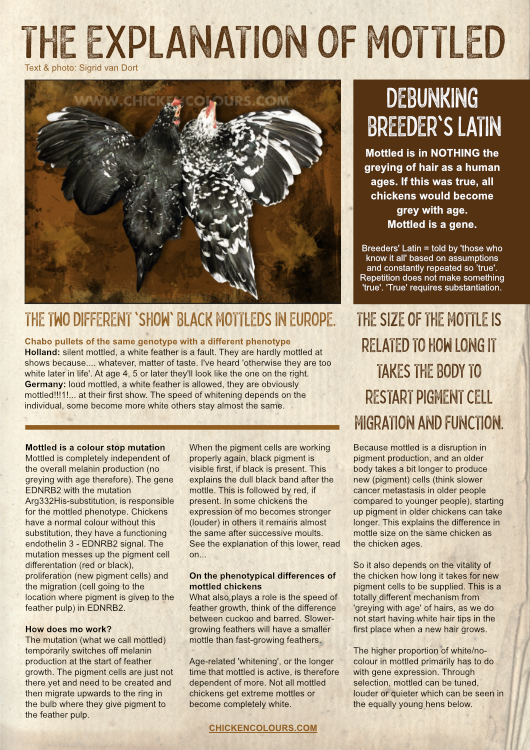
Explanation of mottled
Oct 2022. A short one page article on how mottled works.
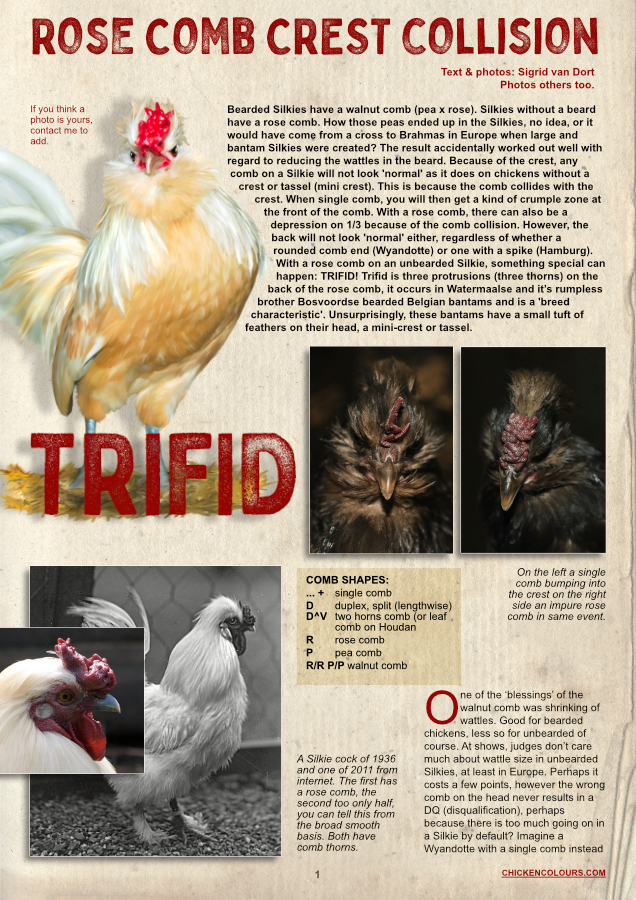
Rose comb crest collision, trifid!
Oct 2022. Long article on the implications of rose comb shape-shifting when there is a crest on the head of a chook. The trifid rose comb.
7 pages, large pdf of almost 4MB with 30 photos to tell about what happens.

Moultus Interruptus
Oct 2022. This is something weird and a chickenfriend asked whether I’ve ever written about it. Nope I didn’t, because to me it is business as usual. Well, it isn’t. So hereby an article on this weird phenomenon without conclusion because I’ve no x-ray eyes. Just the description and proof, to make it real. Enjoy!
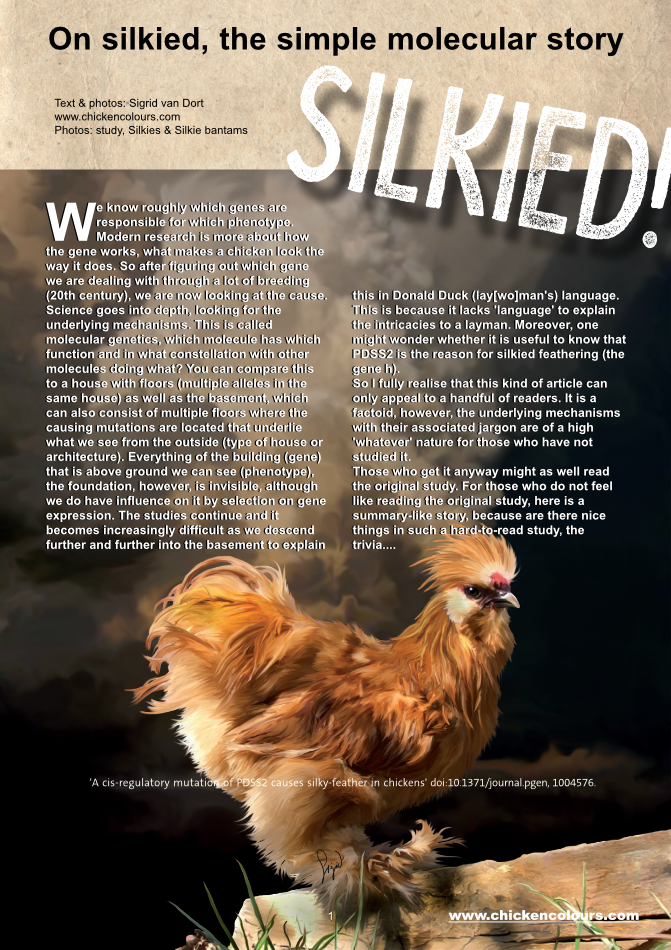
Silkied
Oct 2022. The title and heading tell it all. Nine (9) pages on the specifics of the gene ‘h’ of hookless, how it works on a molecular level in easy wording.

Ancient Wyandottes
Nov 2022. Did you know about American Sebrights or Cochins? Well, I’ve never heard of them, so time to find out what they were. HUH WHAT???, they were Wyandottes??!!!
How come? Why are they called ‘wyandottes’?
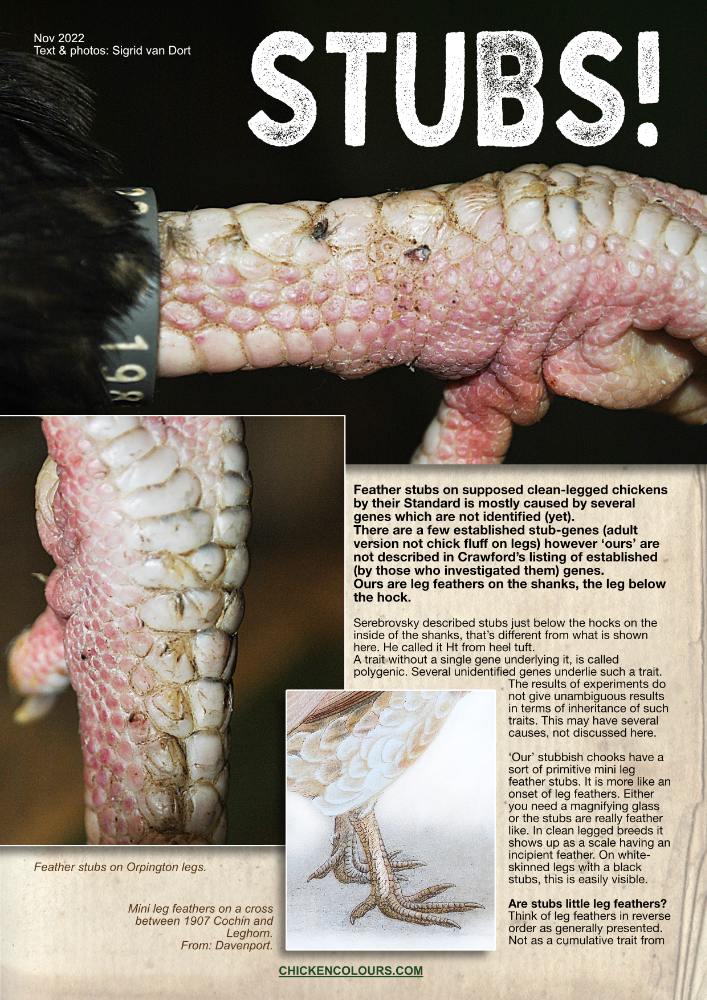
Feather stubs on clean legs
Nov 2022. A trait seen in several ‘new’ breeds. Here the example of Orpington and the origin of this trait. How can you view stubs? Is it a gene? Or several? Some musings in a short article on STUBS.
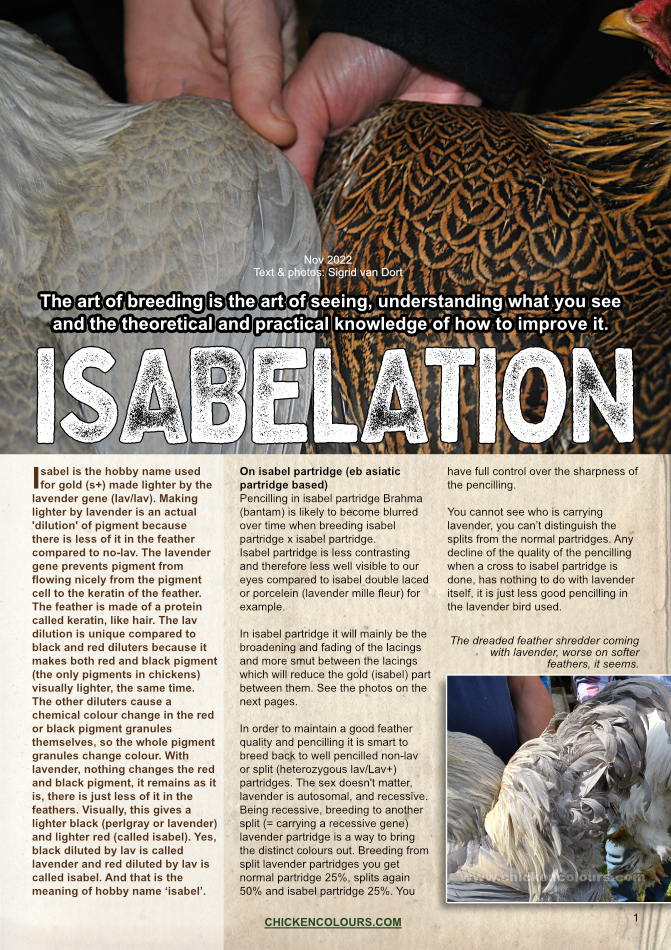
Isabelation or isabelisation
Nov 2022. Making a regular colour isabel (add lavender to a gold based) and breeding them. Hard to see what you are doing. Extra large photos for you to learn to see Things where you have to pay attention to. Here isabel patridge and examples.
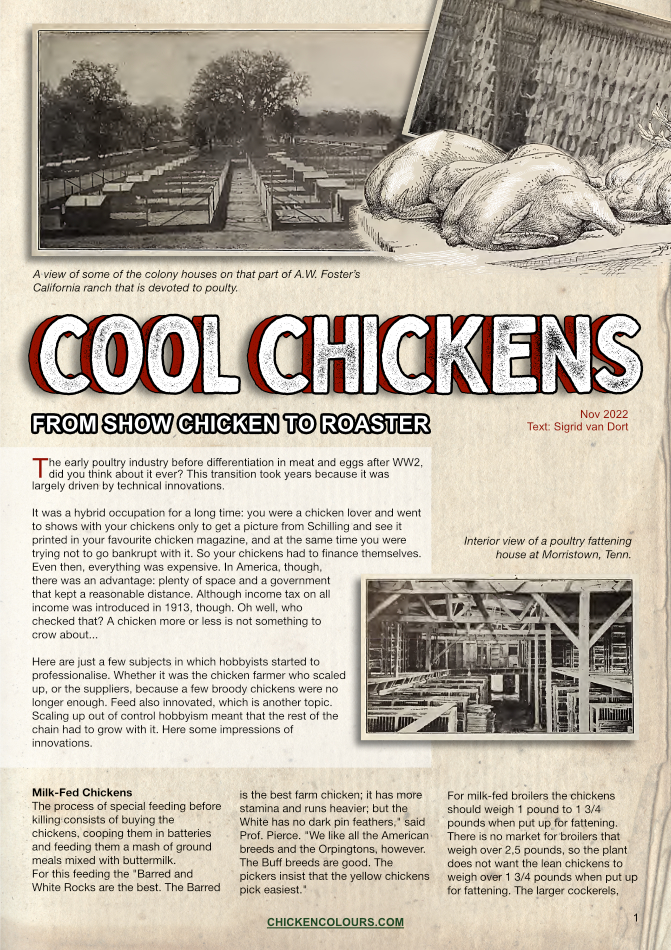
Cool Chickens
Nov 2022. They were literally cool, chilled and then frozen. These were the descendants of the prize-winning chickens at the big shows in 1910-1913 in the USA. Poultry shows were not for chicken lovers as they are now, rather they were for the ambitious poultry man for marketing. The early start of the poultry industry began at the show and the coops became barns…
8 pages, hand picked texts fyi & low res photos from digitised material.
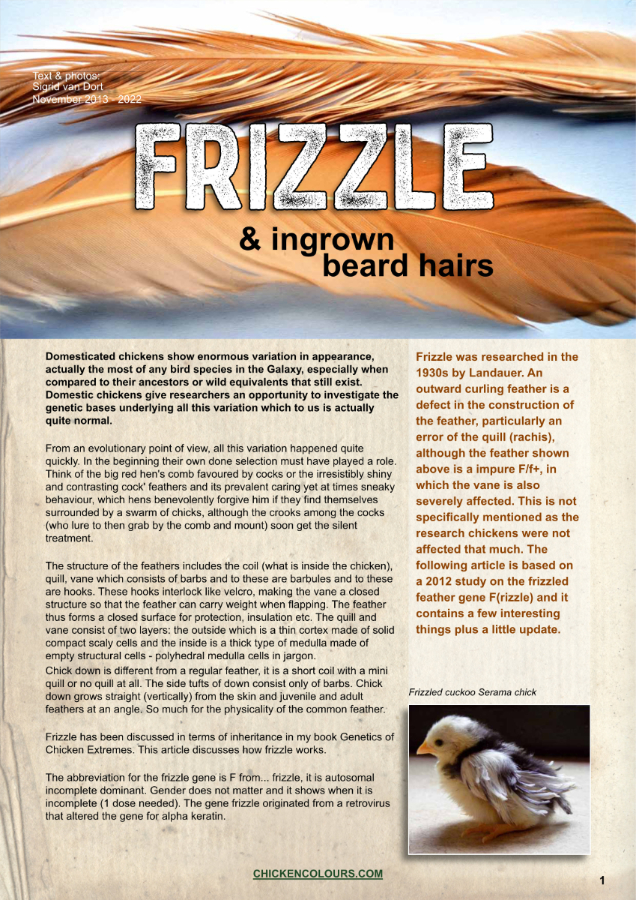
Frizzled chickens, why are they?
Nov 2022. The most simple way of explaining with the help of a few pictures of the original study.
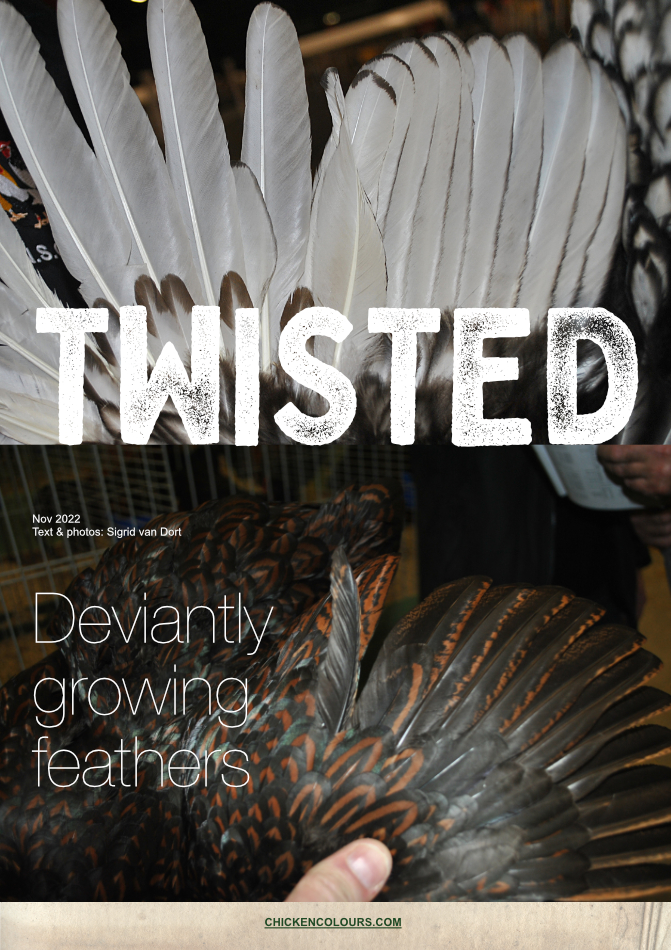
Twisted feathers
Nov 2022. Musings on twisted feathers, possible reasons and some explanation and a little intimidation.
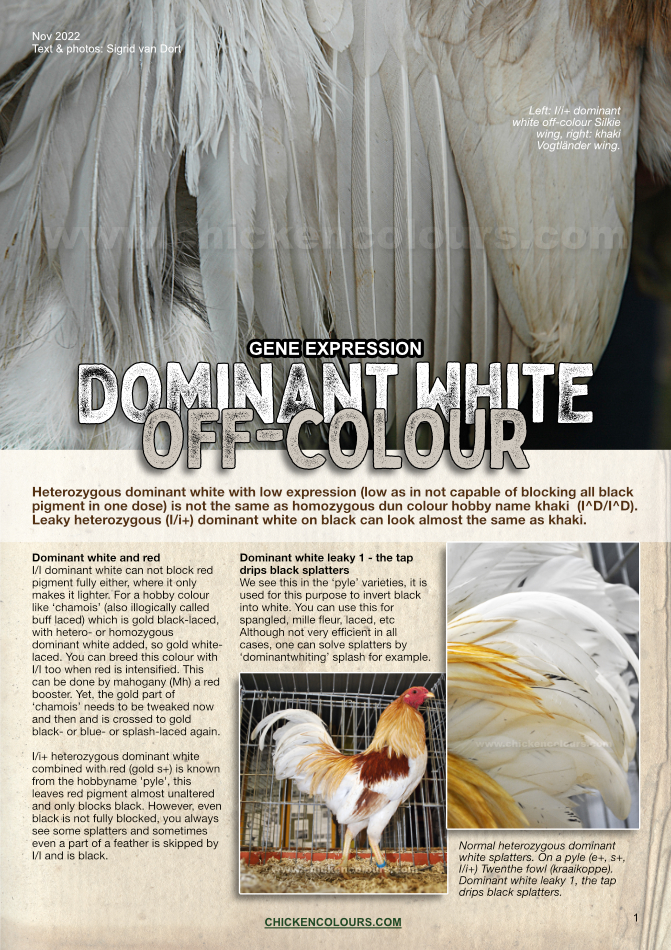
Dominant white off-colour
Nov 2022. …or champagne off-colour as I use to call it too, more in a loving way. Why looks heterozygous dominant white (I/i+) sometimes greyish, almost like khaki (I^D/I^D)? Here a lot of photos and an explanation.

How to colour guess a chicken
Dec 2022. A short article on how you can guess the colour of a chicken by deduction.
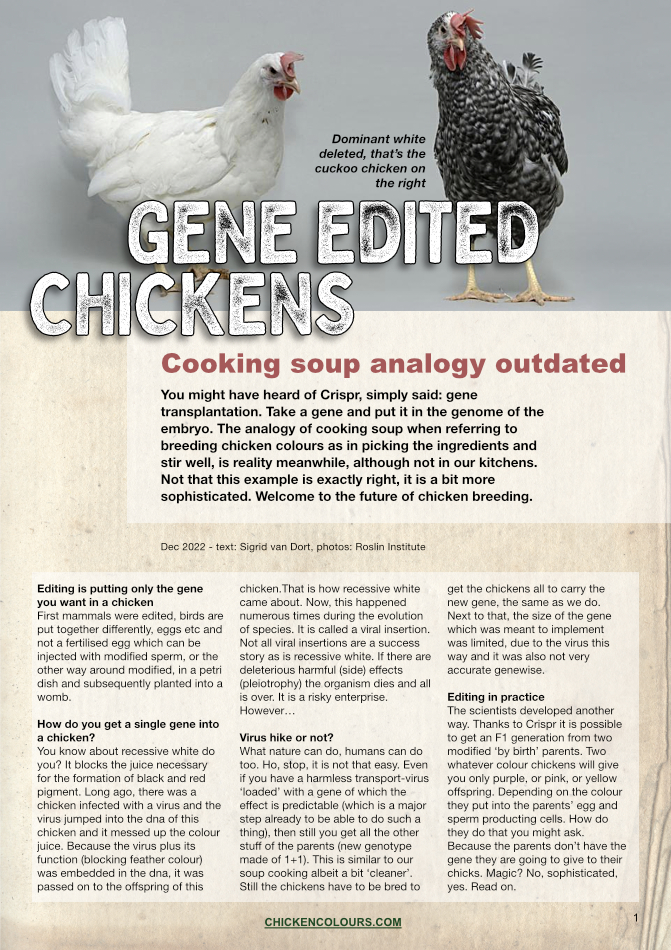
Gene edited chickens
Dec 2022. The shortest and most sophisticated way for adding or removing ONE (1) gene.
Short article on new stuff.

Hens stand less chance against MD
Dec 2022. Science looking for immune-genes in hens with innate immunity against Marek’s Disease and a few other interesting Things.

Legs with wings
Dec 2022. A more recent study revealed a few more things on the inheritance of leg feathers. This is an update of the article above in the E-zine. Some interesting things on brachydactyly too.
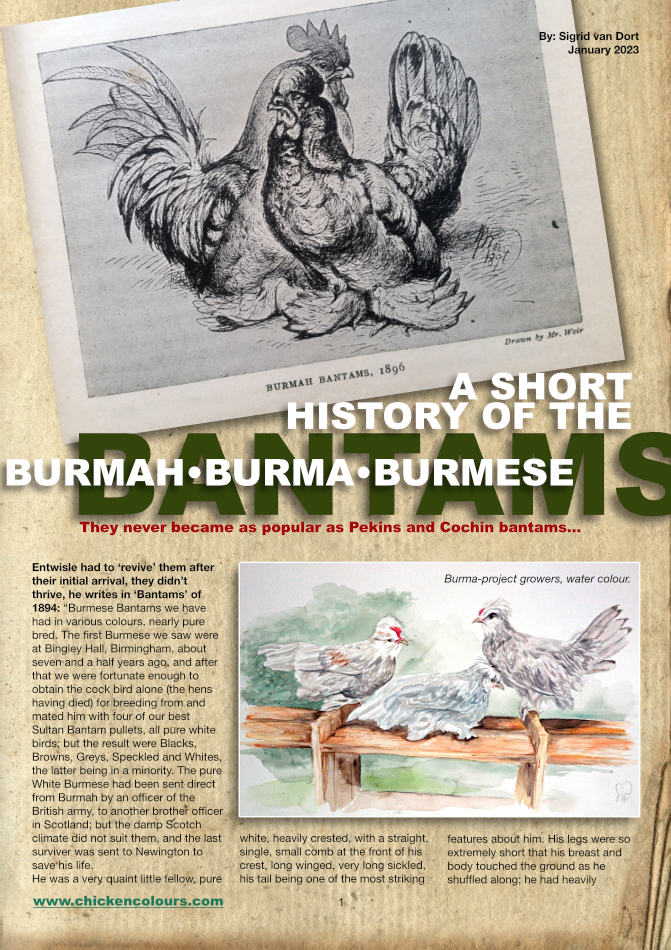
Burmah bantams, short history
Jan 2023. Entwisle and Van Gink on the Burmah bantams. Short article of 3 pages.
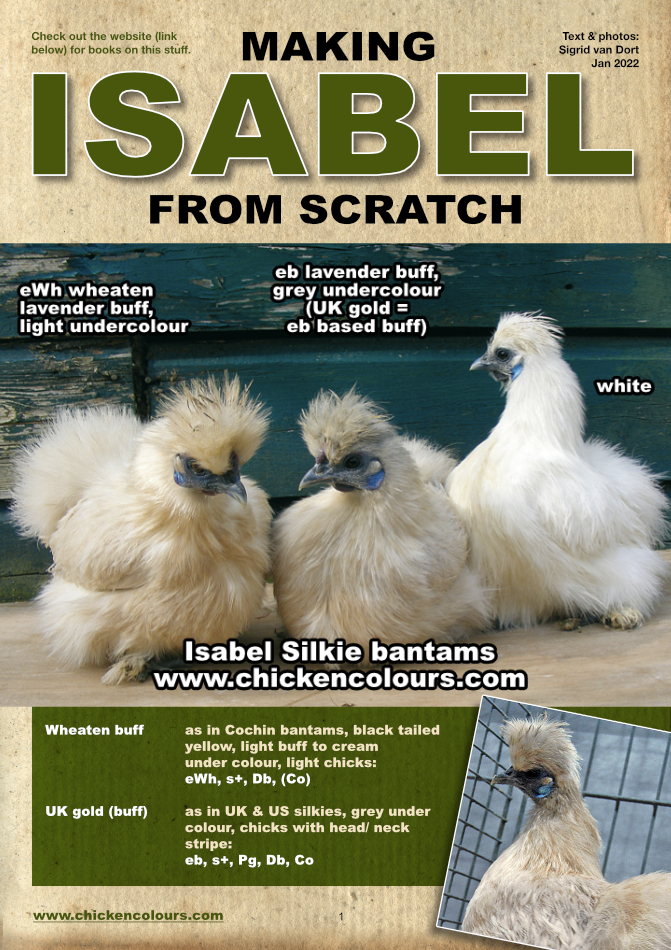
Making (sort of solid) Isabel from scratch
Jan 2023. All the things you might encounter when you decide to make isabel (without a pattern). Every choice you make has consequenes. Read here about them, with loads of photos. 8 pages so a heavy PDF.

Controversy about the vaulted Silkie skull & more on crest and vision
Jan 2023. Not everybody knows why American style Silkies suffer from neurological problems. Here is explained why that is. Plus on the crest and beard of round crested breeds and how to give them their view on the world back and prevent a stink eye. Of course some history too.
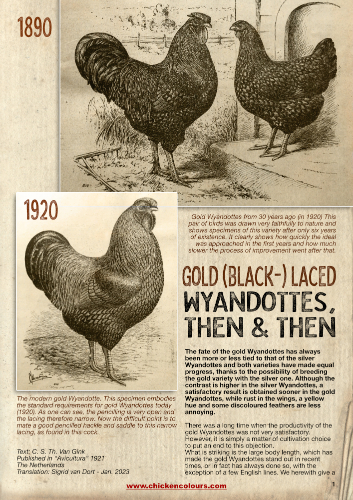
Gold (black-) laced Wyandottes, then and then.
Jan 2023. I’ve translated to English a Dutch article published in 1921 by the great Dutch poultry man (writer & illustrator) Van Gink. I’ve added a couple of more lithographs of the time for reference (German, English). It also shows photographs of the gold Wyandottes of 1916 – quite different from the ideal image, you won’t recognise them as such, however it is explained by Van Gink why they looked so different from the ‘standard’ ones. Pay attention to the back lines and tails.
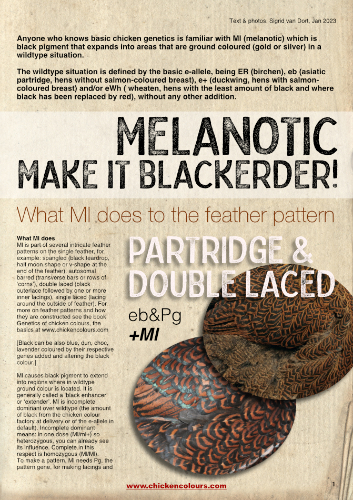
Make it blackerder with Ml!
Jan 2023. Based on three articles from 2014-2021 an explanation on Ml melanotic and the e-alleles. Of course with photos and pictures to show what is told. It is a bit complicated, however I wrote all in normal language and there are bits for the nerds too.
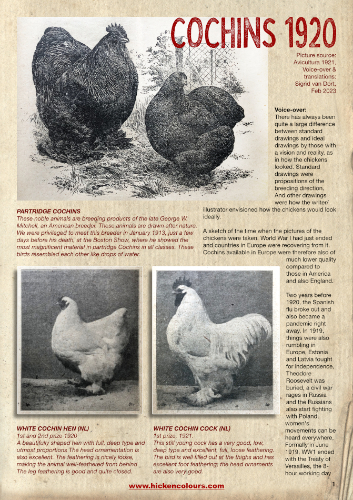
Large Cochins of 100 years ago
Feb 2023. Chickens have always been connected to the history that we as humans have also lived, our ancestors in this case. A look into the past, and you might understand where your place is in chicken history written 100 years from now, like this article about 100 years ago. A look back in time and at the Cochins of that time, and the world history that influenced them.
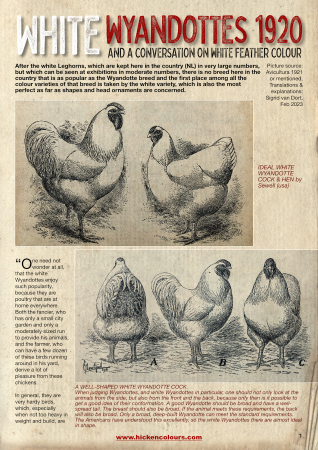
White Wyandottes 100 years ago plus a serious conversation about white feathers and yellow skin
Feb 2023. This article is sort of similar to the large Cochins article of 100 years ago, with added illustrations to follow the changes in shape over time and an explanation why some breeders still think feed colour goes into chicken feathers as in canaries. The origin of why some still think this (Pro tip: read modern literature?) and why this is impossible. 11 pages and ca. 5mb PDF.
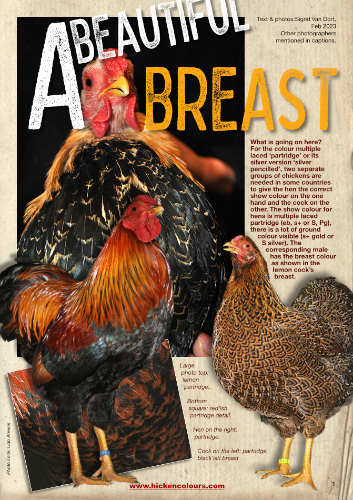
A beautiful breast > eb s+ or S Pg or pg+ in this article
Feb 2023. Difficult to tell in short where it is all about. It is about partridge and the differing breeding directions chosen for defined pencilling in the hens and the breast colour of the males. An overview and explanation with lots of photos as usual.
Seems I cannot use the old layout from above anymore so now a new ugly one:
BACK-mutation, here blue becomes black again.
March 2023. This is about the reverting of a mutation to its default state. In case of blue (Bl) back to black. A little article on this and a possible new allele of blue (bl^d). This window below > there is a slider at the bottom too, so for the last two pages which are a spread, you have to slide it to the right, if the magnification is too large.
I hate NEW things webwise, sorry if you do too. Try to cope ?
Autosomal Red, the English translation of the German article from Udo Ahrens (see Artikel-Deutsch for the original)
March 2023. In red, a distinction is made between the ground colour gold, which is linked to the sex chromosome, and autosomal red. This is what this 5-page article with many pictures is about. Is autosomal red something that is undesirable or is it beautiful and can it be used?
The character of Dun colour
March 2023. A short article (1 page) on dun colour.
Feather: fluff & vane
April 2023. A short article (1 page) on too much fluff or enough vane…
Appenzeller Spitzhauben History Stuff
April 2023. A facebook post ‘article’ised’, 6 pages, with citations from old German books of the 1850+s, translated to English (+ the original badly typed text for translator tool also because gothic letters are not easy to read for most today). PDF for free download (4mb), or read here.
DORKING HISTORY – Large article
April 2023. History of the Dorkings or Kesusu through the eyes of today. A large 13 pages article with plenty of pictures. PDF for free to add to your archive, download (7mb) or read here.
(BLUE) SALMON COLOUR IN BRAHMA, why do that???
May 2023. Helloooww, a short article on how you get (blue) salmon in the Brahma or maybe that’s how it went and an explanation how to swap silver pencilled for silver wheaten with or without blue. A bit of explanation and some parallels with other colours.
Vitiligo in chickens
Coloured chickens moult to white/colourless feathers .
May 2023. A huge article (15 pages) on vitiligo in chickens following questions about it. I spent last working week reading old and new research articles about it and picked out what is interesting to us hobby breeders. On facebook I asked for photos of this phenomenon and they are all included in this article, all phenomena are illustrated with this. A big thank you! I hope all possible questions about this phenomenon have been answered. Links to relevant research papers are active. Note: 11.8mb in size. Download and read 2 pages side by side as this is how the layout is made (this is something aesthetic’ish). Here we go!
Laying cycle of eggs & ‘da bones’
What determines how many eggs a hen will lay before she goes broody or falls into moult?
May 2023. Here a rather ‘scientific’ or if you prefer ‘biological’ article on what determines the above said and how it all works in the hen related to the laying cycle. It is a lot! Free to download or just read it here.
WOOLIE, WOOLLIE, WOOLLY, WOOLY, THE GENE!
May 2023. There is a difference between ‘woolie’ or ‘woollie’ for a double frizzle (F/F) and the GENE ‘woolly’ (w) as it was named in 1956, which is also a feather destruction gene. Here is an article explaining the gene woolie (my spelling choice among many). Purpose: to indicate that the gene woolie has nothing to do with frizzled. The chicken world is full of words that mean something different each time. Hence also this article, that what is called ‘woollie’ or ‘woolie’ on social media has nothing to do with the gene ‘w’.
TWO ROSE COMB ALLELES
Oct 2023. There are two different rose comb alleles, R1, which we know about and which occasionally gives single comb plus reduced fertility in the males, and R2, which does not have these problems. This article is about the discovery of the R2 rose comb allele in 2013. It is an article I wrote at the time and I have now translated it into English. For nerds only….
WHY DO HOMOZYGOUS CREEPER EMBRYOS DIE?
FEB 2024 The creeper gene is known for the very short legs of the, for example, Japanese Chabo.
Breeders of breeds with the creeper gene (there are several breeds) know that a certain number of embryos die in the early stages of incubation.
THE FOUR DIFFERENT CHICKEN BLUES Bl/bl+
March 2024 Blue feather colour can look different and what is written is not always what is seen. This is why blue can be confusing, because …. What kind of blue should a chicken be?
Even blue? Laced blue? Andalusian blue? Dusky blue? Which one for my breed?
WHEN DO CHICKEN EMBRYOS START TO FEEL PAIN?
March 2024 From day 13 of incubation, a chick embryo responds to stimuli, which can be seen on an EEG (brain electricity). This is important to know because male chick embryos may no longer be killed in Germany after day 6 of incubation, according to the law that will come into force on 1 January 2024. But at what point can an embryo feel pain? This was the question that led to the change from day 6 to day 13.
SILKIES: INTERACTIONS OF SKIN COLOUR GENES
MAY 2024 In Silkies weird things can happen, but also when you are making your ‘own breed’ using Silkies and non-black skinned like Cochin Bantams or Serama. Here is a most basic explanation of B cuckoo, id+ and Fm (fibromelanosis) and what they do with and without each other. Plus a few other genes that can mess with skin melanisation.
7 DIFFERENT BUFFS
FEBRUARI 2025 Buff and Buff don’t have to be genetically the same, here are all seven I could think of, plus examples.
THE STORY OF THE BLACK-CRESTED WHITE POLISH IN HOLLAND
April 2025 – I took a Facebook post I made in 2023, tweaked it, and added a bunch of photos to the story to make it into an article. It’s a bit sarcastic in places because I get annoyed when people do ‘their own research’, and just make stuff up. I’ve also included photos of modern Black-Crested White Polish, they are from 2018 because of bird flu and the pandemic and bird flu again etc. I hope you find the story and the publications of the time interesting. It’s a six-page article with lots of pictures.
SEXUAL DIMORPHISM IN CHICKENS
May 2025 – Why does a cock look like a cock featherwise and a hen like a hen? What’s going on with the different outfits when they’re wildtype and therefore don’t have extra genes that change their natural colours.
A one page how and what. The full research is added at the bottom too.
LAVENDER CHICKENS AND BLUE RABBITS HOMOLOGY
June 2025 – I’ve translated an old Dutch article about ‘lavender’ in other animals. If you’re interested in more recent research papers on the genes discussed, Google the title of the paper from which this ‘Donald Duck translation’ article is based.

